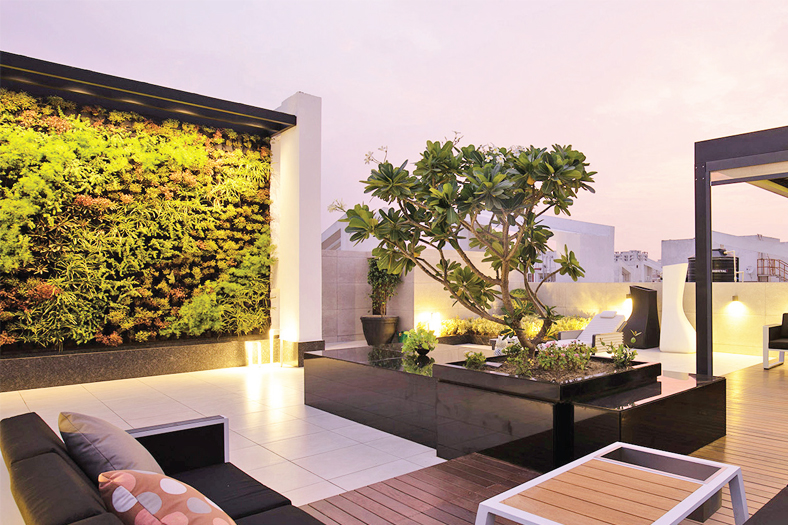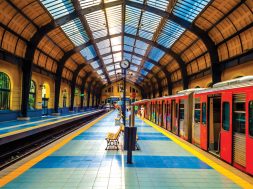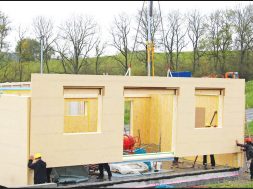Sustainable design prevents depletion of resources

Architecture and design play a crucial role in creating any human settlement respecting solar movement, natural resources and material application.
Energy efficiency can serve as a stepping stone for green growth, eco-efficiency, and sustainable development. A well-conceived energy efficiency strategy enables to improve living standards. An energy-efficient building reduces maintenance and utility costs, also improving durability, reducing noise, increasing comfort and creating a healthy and safe indoor environment.
Functional and aesthetic requirements
Architectural design lies in the task of resolving a wide variety of functional and aesthetic requirements into an articulated satisfying structure. The effort to resolve the varied requirements makes use of specific design elements by assembling the properties of the elements into a coherent whole, says Ar. Er. S.P. Anchuri, Chief Consultant, Anchuri & Anchuri.
Reduce depletion resources
A sustainable design always lessens depletion of resources around like land, water, energy and raw materials which basically averts the destruction of the ecosystem, says Ar. S.K. Goel, Conarch Architects. Reducing unnecessary energy consumption and demand for non-renewable resources provide significant savings in the long run. Placement of buildings and windows, ventilators and other features such as shady landscaping and solar panels are crucial for efficiency.
“One of our recently completed projects is primarily designed with respect to energy efficient principles. To create a spacious home, two separate apartments on top of one another were combined into this luxury penthouse. Connecting the two units internally has major advantage-passive ventilation,” Goel adds.
Effective human settlements
Architecture and design are pivotal creating human settlement respecting solar movement, natural resources and material application. Hence, design provides an opportunity to conserve energy via passive strategies of green architecture in hot and dry climate avoiding penetration of glare, harsh sun and providing just filtered sun light, says Prof. Charanjit Singh Shah, Founding Principal, Creative Group.
Design can reduce energy by 90 per cent and ensures efficiency at the grass root level while planning any project. “We ensure building orientation is kept in a way so that it ensures best of north light and wind to the usable areas,” says Ar. Prem Nath, Prem Nath and Associates.
Prem Nath and Associates’ IGBC Platinum Rate School – Cygnus World School at Vadodara has achieved the best green rating. It is one of the few green projects achieving platinum rating without being fully air-conditioned.
Today, a host of resource conserving ideas are available in the market such as sensors automatically shutting down energy consuming devices during inactivity, heat exchangers converting lost heat from air-conditioning systems into hot water, says Amol Prabhu, Partner, Shashi Prabhu & Associates. Energy saving rating certifications for buildings could adopt any combination of energy saving components thereby supporting their contribution to a greener planet, he added.
Key considerations for construction
Reduce maintenance and utility costs
An energy-efficient building reduces maintenance and utility costs, improves durability, lessens noise, increases comfort and creates a healthy and safe indoor environment. A further goal of energy-efficient construction is to limit damage to the ecosystem and reduce the use of natural resources like energy, land, water, and raw materials, says Anchuri.
Reducing energy consumption is crucial as it means fewer emissions of greenhouse gases, a known cause of global warming. Energy-efficient measures can be integrated into new construction or retrofitted into an existing building.
Achieve net-zero energy homes
The ultimate goal of an energy-efficient building is to achieve net-zero energy use and create a comfortable indoor environmental quality, says Goel.
We believe that designing an energy-efficient building requires a whole building system approach. The whole building system approach makes efficient use of water, electricity and other natural resources and strives to minimise waste and materials, Goel adds.
Adopting local practices
Building orientation, form and mass composition, space organisation, among other factors, can enhance the energy efficiency of a project, says Shah.
Planning methods
There are multiple considerations for every stage of planning, specification and execution of an energy-efficient building; while planning at the grass root level itself needs to be energy efficient, by sound methods; according to Nath. Design strategies for hot and dry region is to ’Resist Heat Gain’ by proper orientation, insulation, cavity walls, decreasing ventilation during the day, says Architect Surinder Bahga, Saakaar Foundation. By promoting heat loss, buildings become very comfortable in this region. Architects need to increase ventilation during night time and increase humidity levels by trees and water bodies. In warm and humid region, there is a need to focus on ensuring proper ventilation. In moderate zone, climate is comparatively less harsh which creates room for design liberty.
Design essentials
Design should make efficient use of water and electricity and other natural sources. It should meet LEED standards, green construction and sustainability of sustainable elements should be intuitive and mandatory to be successfully executed. Adoption of sustainable elements should be intuitive and mandatory to be successfully executed, says Prabhu.
Safe, productive and sustainable
Energy efficient building include measures to reduce energy consumption at the same time create working environment which is safe, productive and sustainable, says Vaibhav Bagul, Business Head, Building Automation Solutions, Delta Electronics India
Delta – Loytec Building Energy Management Systems offers innovative software technology and various international protocols to effectively integrate heating and cooling sources, air conditioning, indoor air quality, ventilation, lighting management, electricity, security and other building facilities.
In all IGBC rating systems, energy efficiency is measured by an efficient thermal envelope (in accordance to standards such as ASHRAE (American Society of Heating & Refrigeration Engineers) and ECBC (Energy Efficiency Building Code), efficient electrical equipment (as rated by BEE (Bureau of Energy Efficiency) of India) and use of renewable energy systems to offset the use of conventional, grid-supplied energy. The application of these measures is quantified by credit points in the rating system which helps define the certification grade of any project, says Mala Singh, Co- Chairperson, IGBC – Mumbai Chapter.
IGBC understands the concern and integrates energy efficiency in every one of its diverse rating systems for different project typologies enabling all stakeholders to achieve energy efficiency in a goal-oriented, effective manner.
Reduction in the usage of natural resources
The consideration that are kept in mind for designing and constructing energy efficient buildings are- limit damage to the ecosystem, reduction in the usage of natural resources like energy, land, water and raw material, reduction in emission of greenhouse gases. Energy efficient measures or products can be integrated into new construction or modified to fit in existing building, says Sameer Saxena, Director Marketing, Legrand (Group) India. Legrand India has an entire range of energy efficient solution starting from XL3 panel, Bus Bar, ACB, MCCB, Capacitors, MCBs, Modular devices, Industrial sockets and Green transformers. “Our products have low energy losses and hence the operating costs are brought down when they are deployed,” adds Saxena.
The company have energy management solution where the devices continuously communicate and share data to web-server and all the various energy and load patterns can be analysed from a central dashboard.
Schneider Electric partners with the company to help empowering various sites in the process with best practices, funding strategies and technology to sustain and optimise performance over time to achieve ambitious and long-range corporate energy and sustainability goals, says Shrinivas Chebbi, President, Buildings Business, Schneider Electric.
Sensitive approach towards local climate
Unsustainable energy supply and demand have serious implications for all; from household budgets to international relations. Buildings are on the front line of this issue because of their high consumption of energy. It is well established now that sustainable development is the only way forward for a secure, stable future on planet Earth. Energy efficiency is a crucial policy in the fight against climate change and global warming.
A sensitive approach towards local climate, building orientation and shading devices with the help of passive architectural studies can be achieved during design stage. After this, procurement of efficient, certified building material with the necessary thermal attributes can help to optimize design, says Mala Singh, MD & Chairperson, PEC Greening India.
While energy efficiency is one of the most significant aspects of sustainability, the performance of installed systems and equipment is of paramount importance to determine efficacy, she adds.
Making designs HVAC-friendly
Implementing passive design strategies
Implementing passive design strategies energy-efficient building requires a well-insulated and air-tight building envelope that minimises transfer of air and thermal energy and creates an energy-efficient, comfortable and resilient building.
LED lighting, high-efficiency HVAC systems, smart thermostats and lighting control systems all support making the design energy efficient, says Anchuri.
Installation of shading devices placement of openings, the design of louvers, installation of shading devices, use of solar panels, landscaping, the building should incorporate as many features as possible to reduce heating and cooling loads, says Goel.
Use of water bodies, fountains and green landscape, insulating materials in the wall, roof and ceiling are some of the key design factors that are more conducive in energy efficiency, says Charanjit.
“Passive cooling with thermal storage in phase change materials (PCMs) is a very effective way to improve thermal stability of the rooms with light – weight envelope,” he added.
Right building design, specification
HVAC system is a top-up to any well planned building, if its orientation is south facing large glazing, the HVAC system shall keep working ‘overtime’ and end-up being a large energy cost component. Similarly, if the roof top is not appropriately insulated, it shall take quite a bit of energy for the HVAC system to ensure right cooling. Thus, right building design and specification are crucial for HVAC system to work efficiently, says Nath.
Detailed study needed
While designing HVAC systems, we need right sizing of plant room, study areas to be air-conditioned, operating hours and calculating demand, says Bahga. Detailed study is needed to calculate walls U-value and its thermal mass, wall window, ratio, position and shading of windows, etc. Tightening building envelope leads to reduced load capacity, usage of environmental resources to enable energy efficiency and separate controls for temperature, ventilation and dehumidification in multiple zones, according to Prabhu.
Key considerations
New construction gives the opportunity to design and build buildings consuming less than or equal amount of energy produced on site through renewable resources. Steps for constructing a modern structure begin with choosing a site and implementing detailed, holistic design plan, says Pankaj Udeshi, Asst. General Manager Procurement, Supreme Infrastructure India Ltd.
Building should be near existing infrastructure to save money and resources. Limiting travel time and using private transportation will reduce wear and tear on vehicles and save gas. Design should easily allow for future retrofits without impacting performance. A continuous layer of insulation around building envelope is essential. Structural insulated panel can save up to 50 per cent in energy costs. Additionally, a cool roof is designed to reflect sunlight and absorb less heat than a standard roof, reducing energy bills, improve indoor comfort, and may extend service life. Proper ventilation is also important.
Reducing energy consumption crucial
Energy-efficient construction integrates solutions that cover all three pillars of energy efficiency, creating and using energy efficiently reducing energy losses. This can be achieved by combining innovative materials and highly developed system technologies. “Reducing energy consumption is crucial because it means fewer emissions of greenhouse gases, a known cause of global warming, says Vijay Kalantri, Chairman and Managing Director, Balaji Infra Projects. Such buildings reduce maintenance and utility costs, improving durability, reducing noise, increasing comfort and creating a healthy indoor environment.
Implementing whole-building systems approach to new construction is recommended since it treats the building as one energy system with separate, but dependent, parts. Design should use natural resources efficiently and strive to meet the Energy Star requirements for sustainability, Leadership in Energy and Environmental Design (LEED) standards, and International Green Construction Code (IgCC). Need of the hour is to build awareness of these methods and practices and promote their systematic application to support modern construction industry.
Green growth, sustainable development
Energy efficiency can serve as a stepping stone for ensuring green growth, eco-efficiency, and sustainable development. A well-conceived strategy will not only result in achievement of goals with lower energy consumption, but also improve quality of life, says Ratan Lal Kashyap, Sr. Vice President – Procurement, G R Infraprojects Ltd.
According to Niraj Bhatia, Head – Strategy, Contracts & Procurement, Viiking Buildinfra Pvt Ltd, designing a glass fagade building has to be proper to save maximum energy through solar panels with nearly transparent PV Glass. Raw materials like AAC Blocks, alternatives of natural sand, etc., are being widely used.
HVAC is the major guzzler of energy, hence automation in HVAC is a must, in addition to having a VRV/VRF system. Building management system (BMS) is imperative in taking corrective actions. With preventive maintenance, one can reduce manpower and downtime thereby reducing cost or losses. Rain harvesting system, efficient STP etc., help reduce load on natural resources.
Architectural design lies in resolving functional and aesthetic requirements into an articulated satisfying structure.
Ar. Er. S.P. Anchuri, Chief Consultant, Anchuri & Anchuri
Sustainable design reduces depletion of natural resources averting destruction of the ecosystem.
Ar. S.K. Goel, Conarch Architects
Building orientation, form and mass composition, among other factors, can enhance the energy efficiency of a project.
Prof. Charanjit Singh Shah, Founding Principal, Creative Group
IGBC integrates energy efficiency in every one of its diverse rating systems for different projects.
Mala Singh, Co- Chairperson, IGBC – Mumbai Chapter
Architecture design is key to achieving energy efficiency in a project at the grass root level while planning any project.
Ar. Prem Nath, Prem Nath and Associates
Energy saving rating certifications for buildings, could adopt any combination of the energy saving components.
Amol Prabhu, Partner, Shashi Prabhu & Associates
A sustainable design aims to lessen depletion of critical resources like land, water, energy, and raw materials.
Vijay Kalantri, Chairman and Managing Director, Balaji Infra Projects
Our products have low energy losses hence operating costs are cut when deployed.
Sameer Saxena, Director Marketing, Legrand (Group) India
Energy-efficient materials can support constructions both ecologically and economically.
Ratan Lal Kashyap, Sr. Vice President – Procurement, G R Infraprojects Ltd
Building management system (BMS) plays a very important role in taking corrective actions.
Niraj Bhatia, Head – Strategy, Contracts & Procurement, Viiking Buildinfra Pvt Ltd
Energy-efficient building create an environment that is safe, productive and sustainable for living.
Vaibhav Bagul, Business Head, Building Automation Solutions, Delta Electronics India
We partner with the company to help empower various sites in the process with best practices, funding strategies and technology.
Shrinivas Chebbi, President, Buildings Business, Schneider Electric
19
Cookie Consent
We use cookies to personalize your experience. By continuing to visit this website you agree to our Terms & Conditions, Privacy Policy and Cookie Policy.









